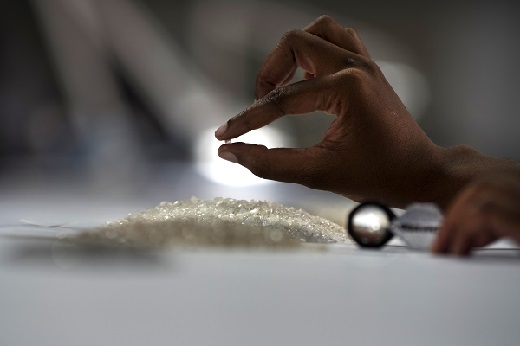
Gaborone, Botswana — November 2025:
Botswana’s move to secure majority control of De Beers, the world’s most iconic diamond company, marks a turning point in both African resource ownership and the global diamond market. The initiative, driven by President Duma Boko, represents one of the most significant sovereignty shifts in modern mining history, with potential to reshape how nations manage their natural wealth.
Why Botswana’s De Beers Acquisition Matters
Diamonds remain the cornerstone of Botswana’s economy — contributing nearly 30% to GDP and 80% of export earnings. Through its long-standing Debswana partnership with De Beers, the country has benefited from steady revenues but limited control over the strategic direction of its most vital industry.
Now, Botswana aims to change that. By pursuing a majority stake, the government seeks greater influence over production, marketing, and profit allocation — a shift that could transform the balance of power in the global diamond trade.
Current Ownership and Partnership Structure
Currently, Anglo American holds 85% of De Beers, while Botswana owns 15% through Debswana. Though this structure has delivered stability and growth, it also leaves Botswana as a minority player in decisions that directly affect its economy.
With Anglo American now restructuring its portfolio and considering divestment, Botswana has seized a rare opportunity to negotiate for majority control — aligning national interest with long-term sustainability and independence.
Economic Impact and Strategic Motivation
Diamonds have built Botswana’s success story, funding education, infrastructure, and healthcare. Yet, with rising competition from lab-grown diamonds and volatile global demand, the government recognises the need to safeguard revenue and ensure future resilience.
Majority control would allow Botswana to:
- Align De Beers’ strategy with national priorities
- Increase direct revenue and value capture
- Enhance job creation through local beneficiation
- Strengthen resilience against external market shocks
Understanding the De Beers Restructuring Opportunity
Anglo American’s decision to offload assets amid global portfolio optimisation has opened the door for Botswana’s historic bid. Market analysts suggest that De Beers’ valuation — affected by softer diamond demand — may now be more accessible, creating a once-in-a-generation acquisition opportunity for Botswana.
International sovereign wealth funds, including potential partners from Oman, have expressed interest in co-financing the acquisition, signalling global confidence in Botswana’s governance and the enduring value of natural diamonds.
Regional Competition and Cooperation
Botswana’s bid faces competition from Angola’s Endiama EP, which has also expressed interest in acquiring Anglo American’s stake. However, diplomatic discussions between Botswana and Angola hint at possible collaboration, with joint African ownership of De Beers emerging as a strategic alternative that could reinforce continental resource sovereignty.
Global Diamond Market Implications
If successful, Botswana’s acquisition would mark a paradigm shift:
- African Resource Sovereignty: Establishing Botswana as a model for other resource-rich nations pursuing local ownership.
- Supply Chain Control: Enhancing Africa’s ability to influence global pricing, production, and distribution strategies.
- Market Stability: Strengthening natural diamond positioning against synthetic competitors through unified African leadership.
With potential to contribute over 35% to Botswana’s GDP and maintain its dominance in global exports, majority ownership could significantly enhance the nation’s economic resilience and international influence.
Challenges and Market Outlook
The acquisition faces hurdles, including valuation complexities, competitive bidding, and global demand fluctuations. Moreover, the diamond industry continues to navigate pressures from lab-grown alternatives, changing consumer preferences, and macroeconomic uncertainties.
Nevertheless, Botswana’s strategy demonstrates forward-thinking leadership — leveraging its expertise, governance stability, and long-term vision to secure sustainable control over its most valuable resource.
President Duma Boko’s Vision
“Government will leverage a majority stake. Concrete steps are under way towards the acquisition of Anglo American shares in De Beers,”
— President Duma Boko, addressing Parliament, November 2025
His statement underscores Botswana’s commitment to advancing economic independence while setting a precedent for African nations reclaiming control of their mineral wealth.
What This Means for the Future
Should Botswana succeed, it will become the first African nation to hold majority ownership of the world’s largest diamond company — a move that could redefine the global diamond landscape for decades to come.
Beyond national pride, this transition represents a strategic realignment of power, giving Botswana direct control over pricing, marketing, and supply chain dynamics in the international diamond market.
Frequently Asked Questions
When will the Botswana De Beers deal be finalised?
Negotiations are ongoing through late 2025. Completion depends on final agreements with Anglo American and potential co-investors.
How much will Botswana pay for majority control?
Financial details remain confidential, with valuations influenced by current market conditions and strategic negotiations.
Will this affect global diamond prices?
Yes — greater African control over supply could strengthen natural diamond pricing and reinforce consumer confidence in ethically sourced stones.
About DCLA
The Diamond Certification Laboratory of Australia (DCLA) is Australia’s official CIBJO-recognised laboratory, providing independent grading, authentication, and certification of natural diamonds. DCLA continues to report on global developments shaping the natural diamond industry, ensuring transparency and consumer confidence worldwide.
Disclaimer: This article is intended for informational and educational purposes only. The views and interpretations expressed do not necessarily reflect those of the Diamond Certification Laboratory of Australia (DCLA). All information is based on publicly available data and current market reports at the time of publication. DCLA does not provide financial, investment, or legal advice. Readers are encouraged to conduct their own research or consult with qualified professionals before making decisions related to diamond investment, trading, or acquisition.